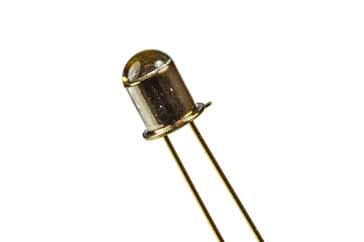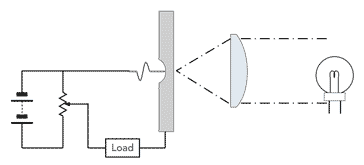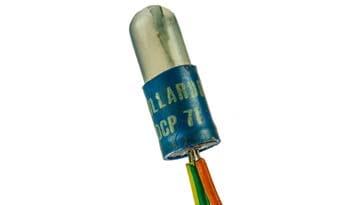Phototransistor Invention & History
The phototransistor was developed after the basic point contact transistor when it was discovered that light could also enable collector emitter current to flow.
Transistor History Includes:
Transistor history
First silicon transistor
Phototransistor invention
FET invention
More semiconductor history
History of semiconductor technology development
PN junction diode invention
Invention of the integrated circuit
In the late 1940s at Bell Labs a raft of teams were looking at different areas of semiconductor technology. Spurred on by the invention of the point contact transistor a number of other developments were announced and although they are not as widely publicised, they also had a major impact on the advancement of the electronics industry.
One early but very significant development that occurred early on in the history of the transistor was that of the phototransistor.Nowadays, phototransistor technology is taken for granted, and the devices are widely used, but nevertheless this was an important semiconductor technology development.
Phototransistor device
The phototransistor is now a mature technology and the device can be used in many areas of electronic circuit design.
The phototransistor is one of a number of photo-detecting devices and this enables circuit designers to have a good choice of components selecting the best one for their particular circuit design.
Note on the Phototransistor Device:
Phototransistors are used in many electronic circuit designs to enable light detection. They offer a combination of sensitivity and reasonable speed which is ideal for many applications.
Read more about Phototransistor & How it Works

Phototransistor initial development
Once the basic point contact transistor had been developed, many other investigations started at Bell Labs and new teams started to look at different areas of semiconductor technology.
A team working under the leadership of Dr John Northrup Shive was developing semiconductor devices that were similar to the point contact transistors that had been announced in 1947.
Starting work in 1948, Shrive was investigating the effects of light beams on transistor devices to see whether this would be another method that would generate holes to flow to the collector.
The experiments were successful and this enabled the phototransistor to be born.
The Bell telephone Laboratories announced invention of the phototransistor on 30th March 1948. They also showed a transistor device that was housed in a small cylindrical package to enable the light to reach the base junction area which was sensitive to light.
Bell announced the invention of the phototransistor when it was still in its experimental stages, but they were very confident of its importance and its success.
It had many advantages over existing light cells that tended to be large, slow to respond and not particularly sensitive. They were used for a variety of applications including the detection of automatic doors, where the breaking of a light beam indicated a particular state.
Phototransistor patent
The patent application for the photo transistor was filed by Shive in 1949 where it was described as "photoresistive translating device."
While the patent was filed in 1949 some time after the announcement from Bell Labs, it took until 1951 before the patent was granted as US patent 2 560 606.
Transistor technology was very basic in these early days of the technology. Shive's laboratory device used a single wire that had its end resting in a small dimple ground into one side of a germanium disk to form the collector. Then light was focussed using a lens onto the opposite side of the germanium disk to control the flow of current in the device.

Initially the device was referred to an an "electric eye" and it provided several advantages over previous light sensitive cels that were larger and slower to respond.
Application in long distance telephone dialling
After the phototransistor had been developed and launched, it started to gain significant levels of use. Bell Labs had been looking at automated methods of making long distance calls, and the phototransistor started to be used within this application, giving it an early impetus to its use.
Although it sounds very archaic now, the computer technology we have today was not available then. To assist with the long distance dialling, a form of card system was invented to assist with the level of information that was required, and the phototransistor was used to detect the information held on the cards.
A system using punched holes on metal cards was able to provide the required instruction on how calls should be handled.
The routing information for calls was in the form of a code that was stored on punched steel cards. When a call was received, the system would select the relevant card. The system would then read this using a system of light beams and photo-transistors. The overall scheme also allowed fort he fact that if the preferred routing for the call was in use, then it would select an alternative.
It was also easy to update the system when new instructions were needed as this was simply achieved by replacing the old card with its data by a new one with the up to data information.
This light operated card system was able to significantly improve the long distance calls that were normally set up manually by operators.
Later devices
As the phototransistor started to become more widely accepted and its uses understood, many of the early transistor manufacturers of the day manufactured them.
Naturally, after transistor technology as a whole started to be used more widely, a variety of other manufacturers started to manufacture phototransistors.In the UK, Mullard developed their OCP71 phototransistor and introduced in it 1956. This was a version of their OC71 germanium transistor.

The OCP71 was more expensive than the OC71 and many hobbyists just scraped the black paint off the exterior of the OC71 and this responded to light. There were stories that the OCP71 was just an OC71 but with a clear package.
This is not exactly true. Transistor manufacturing of the time gave significant variability of transistor parameters, especially between batches. Accordingly the different types were often as a result of a selection process. The OCP71 was selected for better light detection, and it was also packaged differently.
The basic OC71 transistor device itself was dipped in a light blue putty material and then covered in a paste that reduced light transmission and conducted heat away. Finally the device was encapsulated within its glass package which was painted black and marked. The reason for this light protection was to ensure the performance remained constant whatever the light levels.
The OCP71 was packaged differently using a clear silicon grease that gave much better light conduction as well as providing heat transfer away from the semiconductor device itself.
Germanium to silicon transition
The early phototransistors were all manufactured from germanium. Germanium was the preferred semiconductor material at the time as it was easier to refine to the degree needed for device manufacture.
All the early devices, including Shive's first phototransistor were made from germanium.
As silicon technology developed, phototransistors started to be use silicon as the base material.
Phototransistors are now widely available at very low cost. Their performance is very good compared to the original devices, with large areas for receiving the light.
Although modern phototransistors have a far higher degree of performance than the original ones, they are not high speed devices, but they are able to offer a high level of sensitivity.
It is interesting to follow the history of the phototransistor and see the timeline of when it was developed.
 Written by Ian Poole .
Written by Ian Poole .
Experienced electronics engineer and author.
More History:
Radio history timeline
History of the radio
Ham radio history
Coherer
Crystal radio
Magnetic detector
Spark transmitter
Morse telegraph
Valve / tube history
PN junction diode invention
Transistor
Integrated circuit
Quartz crystals
Classic radios
Mobile telecoms history
Vintage mobile phones
Return to History menu . . .



